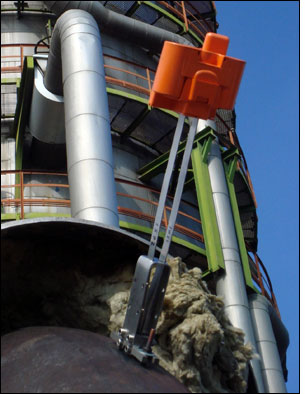Oil company BP is installing a corrosion-monitoring system for steel pipes at its 11 refineries around the world, following several years of testing the RFID sensor system at two refineries to track the corrosion of the metal walls of its oil-bearing pipes. The solution, provided by Permasense—a firm launched by researchers at Imperial College London—allows the oil company to attach the battery-powered wireless sensors to the pipes’ exterior, thereby enabling it to remotely measure the thickness of each pipe’s walls.
BP first approached Imperial College London for a system that would allow the company to track the condition of its refineries’ infrastructure. The research team developed and tested battery-powered waveguide-mounted sensors—for which there are several patents pending—that employ ultrasonic technology to gauge the exact thickness of pipe walls, and then utilize the sensor’s built-in radio chip and antenna to transmit that sensor data, along with a unique ID number, via an active 2.4 GHz transmission with a proprietary air-interface protocol.
Oil companies, especially those with an aging infrastructure, can find it challenging to monitor the quality of pipes that carry oil at wells and refineries. Crude oil is highly acidic, according to Peter Collins, Permasense’s CEO—and is becoming more so as companies drill deeper wells that can affect oil quality—and can thus corrode the pipes through which it travels. It can be difficult to measure how badly a pipe has corroded, and the speed at which such damage is occurring. Traditionally, oil companies manually inspect their pipes at refineries by shutting down the pipes in question, using an ultrasonic device to measure the thickness of each pipe’s metal wall, and then manually recording the results on a spreadsheet.
The process is costly, however, because a refinery’s operating units must be turned off in order to accomplish the work. What’s more, since manual testing is conducted only once every few years, it does not provide as much data as many companies would like. In addition, Collins says, such testing is prone to error, since it can be hard to identify the exact section of pipe on which a test is being carried out, making it difficult to compare the results of tests previously conducted on that particular pipe. And errors can be made when manually recording data as well.
In 2006, BP approached Imperial College London for potential solutions. Researchers at the university began developing a wireless system to measure pipe walls while the refinery remains in operation, and then wirelessly transmit that information to a gateway, via a mesh network of RFID sensors. The research team tested the system, and built software to capture the measurement data and display it for end users. The solution was first trialed at BP’s refineries in Cherry Point, Wash., and Gelsenkirchen, Germany.Based on the results of those trials, BP is now in the process of installing the system at all 11 of its refineries worldwide (located in Australia, Europe and North America), with six installed and operating to date. In the meantime, the researchers launched Permasense in 2009 to continue developing and marketing the product for use with other oil firms.
According to Collins, BP intends to install thousands of sensors over the next few years. (BP did not respond to requests for comments.) Thus far, one refinery is installing more than 1,000 sensors, while the others are starting with fewer units. Each sensor sends ultrasonic waves into a pipe wall, and measures the waves reflected back. The walls of uncorroded pipes range from 3 millimeters to 25 millimeters (0.1 inch to 1 inch) in thickness, and the system can sense a loss of as small as 0.1 millimeter (0.004 inch). Each sensor’s radio chip transmits its unique ID number and the measurement data at preset intervals.
The closest neighboring Permasense unit receives that RF signal (the tag’s maximum transmission range is about 55 yards), and then transmits that sensor’s data to the next device, along with its own information, thereby creating a mesh network. All data is received by a gateway wired to a PC. Permasense software, residing either on the PC or on a server hosted by BP, stores that information, interprets it and makes it available to engineers and refinery management via the Internet.
To modify the sensor unit so that it can sustain the high pipe temperatures—which can exceed 1,000 degrees Fahrenheit (538 degrees Celsius)—the sensor and RFID hardware is housed in a plastic casing and attached to the pipe wall via a set of legs, about 12 inches in length, through which the ultrasound waves are transmitted and received. The outer tips of those legs are attached to a mounting welded directly to the pipe.
In the future, Collins says, each of BP’s refineries could use tens of thousands of sensors. Permasense has been marketing the system to other oil companies since the fall of 2010, and is currently in conversations with those interested in employing the technology.



